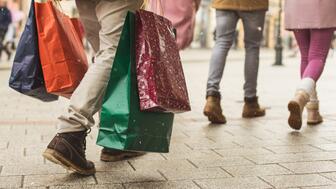Squirrel Spotting: The Travails of Attracting and Retaining Talent
The job market is tight, making it paramount for employers to have the type of culture employees really crave, Peter Smith writes.

Retail, in fact, has recovered so well that there are now 208,000 more people employed in the sector than in February 2020, the month before the onset of the pandemic in the United States.
As impressive as those numbers are, however, they signal potentially significant problems for employers in both attracting new talent and, more importantly, retaining their top people.
We are now firmly ensconced in a “buyer’s market” in which employees hold most of the cards. Rarely have they had such leverage when it comes to deciding to stay with their current employers or seek greener pastures elsewhere.
According to Zippia, 65 percent of Americans are actively searching for a new job right now.
In the 2001-2007 version of The Best of Gallup Management Journal, Brian Brim wrote, “Though companies may recognize how crucial it is to engage their workers and may even acknowledge that it must be an ongoing process, the essential principles of employee engagement have not become ingrained.”
If 65 percent of employees are actively searching for new jobs, it is hard to imagine that circumstances have changed much in the 10-plus years since Brim’s article.
“Stop bullshitting people about how great your culture is. If it were true, you wouldn’t be losing people.”
So, what can be done? How can employers mitigate against the possibility of losing their top people and also become more attractive to quality professionals looking for a change?
For starters, stop bullshitting people about how great your culture is. If it were true, you wouldn’t be losing people, and you’d be decidedly more attractive to candidates already in the market for a new job.
You can determine what’s important in your company; the way you treat your people, the compensation structures (for good or bad), whether you invest in your people or not, the things you celebrate, and the things you tolerate.
Despite that, to a great extent your culture is not what you say it is but, rather, what your people experience on a daily basis.
You may believe your culture reflects your values and aspirations, but it may read entirely differently to your current team and to potential new hires.
I visited with a company recently and witnessed a culture that was as close to soul-sapping as I could have imagined. Despite there being lots of people in the space, there was no energy at all in the building.
The employees didn’t look like they were having much fun, and I saw precious little evidence of people joyfully engaging with each other.
As I walked around, I noticed that the desks and cubicles were devoid of the personalization so typical of these types of offices, with scant evidence of family, hobbies, or other interests.
There also was no music playing; the overall effect was of a dour, uninspiring, and impersonal space.
I suspect the leadership of that company would be shocked at my observations, preferring to believe, as many do, that they have a vibrant company culture.
What I saw and felt however, was very different, and that is what I took away with me.
At the most basic level, people want to feel safe and connected at work.
They want a company and mission worth believing in, and they want to know their voices will be heard, and their opinions matter.
They want a culture that prizes innovation and recognizes and welcomes mistakes as a necessary consequence of that open mindset.
Roger Martin, former dean of the Rotman School of Management at the University of Toronto, wrote in the Harvard Business Review (March-April 2022), “Do you have to listen to everything top talent has to say? Of course not. But recognize that talented people don’t take kindly to being dismissed out of hand. And they always have options, options that may be highly damaging to you.”
They want the opportunity to make money in a company that does not impose a ceiling on the earnings of its top people, but what they really want is a career path, an opportunity to do great and meaningful work.
They want to be surrounded by other top talent, and they want a company that invests in them, and which gives them an opportunity for professional development.
They want a company where loyalty is a two-way street (that does not mean the absence of turnover, but a clear sense of what matters most in hiring and exiting employees) and one where all employees are treated with respect, including people who are leaving, or have left, the company.
They want a company where wins, big and small, are celebrated, and where disappointments are acknowledged and owned, without stigmatization or over-dramatization. Good teams don’t suck because a company has a bad month.
As Jim Collins wrote in “Good To Great,” “What do the right people want more than almost anything else? They want to be part of a winning team. They want to contribute to producing visible, tangible results. They want to feel the excitement of being involved in something that just flat-out works.”
If you are one of the many companies still offering an hourly wage and one week’s vacation as an incentive to retain and attract top talent, you’ve got a tough road ahead.
The Latest

The couple pleaded guilty to concealing at least $127 million in cash transactions at its precious metals businesses.

Consumers shared concerns about prices, inflation, tariffs, trade, and politics in the survey’s write-in response section.

In February 2026, the auction house will move its headquarters to the former Steinway Hall, a neoclassical landmark on Billionaires’ Row.

How Jewelers of America’s 20 Under 40 are leading to ensure a brighter future for the jewelry industry.

The new show will take place Jan. 23-25, 2026.


The former BHP Billiton leader and Gemfields chairman is remembered for his influential leadership throughout his 50-year mining career.

The LVMH-owned brand has partnered with the costume design union to revamp its award for 2026.

Roseco’s 704-page catalog showcases new lab-grown diamonds, findings, tools & more—available in print or interactive digital editions.

The luxury titan inked a deal to acquire an initial minority stake in the jewelry manufacturer with a pathway to full ownership by 2032.

The company’s curation of unsigned vintage and estate jewelry debuted at the Bloomingdale’s in Costa Mesa, California.

In the recent multi-shipment seizure, CBP also found counterfeit Audemars Piguet, Moncler, and Chrome Hearts items.

Helzberg’s Chief Retail Officer Mitch Maggart shared details about its tests of a new store concept rooted in an elevated luxury experience.

Jewelers of America execs and National Jeweler editors discuss tariffs, the sky-high gold price, and the engagement that broke the internet.

The luxury goods company said founder Ippolita Rostagno will remain at the brand’s helm.

Laura Burdese, who joined the Italian luxury brand in 2022, will take on the role in July.

The National Jeweler editors revisit the most noteworthy industry happenings and design trends from 2025.

Need a gift for the cat lover who has everything? Look no further than our latest Piece of the Week.

It purchased the “Grosse Pièce,” an ultra-complicated Audemars Piguet pocket watch from the ‘20s, for a record-breaking price at Sotheby’s.

The lab-grown diamond grower now offers custom engagement and fashion jewelry through its Kira Custom Lab Jewelry service.

Chandler got his start at Michelson Jewelers and has served as DCA president and CEO since 2001. He will retire at the end of the month.

The boutique is slated to open this week inside Terminal 8, offering pre-owned Rolex watches and more to international travelers.

Sponsored by Digital Monitoring Products

The special-edition egg pendant ingested in a New Zealand jewelry store was recovered after a six-day wait.

Associate Editor Natalie Francisco plays favorites with Piece of the Week, selecting a standout piece of jewelry from each month of 2025.

The “Love and Desire” campaign is inspired by the magic that follows when one’s heart leads the way, said the brand.

Two awardees will receive free tuition for an educational course at the Swiss lab, with flights and lodging included.

Berta de Pablos-Barbier will replace Alexander Lacik at the start of January, two months earlier than expected.





























